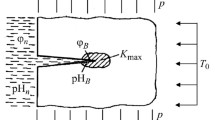Abstract
We construct a numerical model of subcritical growth of cracks in metals subjected to the simultaneous action of loading and corrosive hydrogen-containing media. The model is based on the hypothesis that hydrogen plays the predominant role, that under the conditions of stress corrosion, the process of crack growth passes through two stages, and on the deformation criterion of fracture. The crack-growth rate was determined as a function of the crack tip opening displacement δ, its critical value δc, standard electrode potential of the metalE 0, and pH value of the medium. The reliability of the model under consideration is corroborated by experimental results.
Similar content being viewed by others
References
O. E. Andreikiv and N. I. Tym'yak, “Electrochemical model of local corrosion at the tip of a loaded crack,”Fiz.-Khim. Mekh. Mater.,30, No. 1, 25–29 (1994).
V. V. Panasyuk, O. E. Andreikiv, and V. S. Kharin, “Theoretical analysis of the process of crack growth in metals under the influence of hydrogen,”Fiz.-Khim. Mekh. Mater.,17, No. 4, 61–75 (1981).
V. V. Panasyuk, O. E. Andreikiv, and O. I. Obukhivs'kyi, “Numerical model of crack growth in metals under the influence of hydrogen,”Fiz.-Khim. Mekh. Mater.,20, No. 3, 3–6 (1984).
I. M. Dmytrakh, “Effect of tensile stresses on the parameters of corrosion processes in model cracks-slots,”Fiz.-Khim. Mekh. Mater.,26, No. 4, 22–25 (1990).
F. F. Azhogin,Corrosion Cracking and Protection of High-Strength Steels [in Russian], Metallurgiya, Moscow (1974).
L. N. Petrov, “On the mechanism of local corrosion in cracks of corrosion cracking,”Fiz.-Khim. Mekh. Mater.,26, No. 4, 3–8 (1994).
A. V. Fishgoit, T. N. Zueva, N. G. Bychkov, and L. F. Kurnosova, “Kinetics of electrochemical hydrogenation of nickel alloys under the influence of plastic deformation,”Fiz.-Khim. Mekh. Mater.,24, No. 3, 42–47 (1988).
R. P. Gangloff, “Crack tip modelling of hydrogen environment: application to fracture life predictions,”Mater. Sci. Eng.,A103, No. 1, 157–166 (1988).
V. V. Panasyuk (editor),Fracture Mechanics and Strength of Materials. A Handbook [in Russian], Vol. 4, Naukova Dumka, Kiev (1990).
Additional information
Karpenko Physicomechanical Institute, Ukrainian Academy of Sciences, L'viv. Translated from Fiziko-Khimicheskaya Mekhanika Materialov, Vol. 31, No. 2, pp. 68–74, March – April, 1995.
Rights and permissions
About this article
Cite this article
Tym'yak, N.I., Andreikiv, O.E. Evaluation of crack-growth rate under conditions of simultaneous action of static loading and corrosive media. Mater Sci 31, 219–225 (1996). https://doi.org/10.1007/BF00558642
Received:
Issue Date:
DOI: https://doi.org/10.1007/BF00558642



